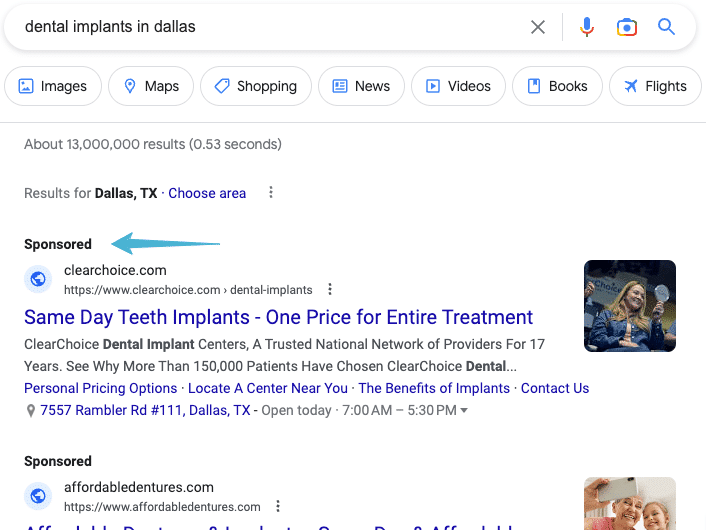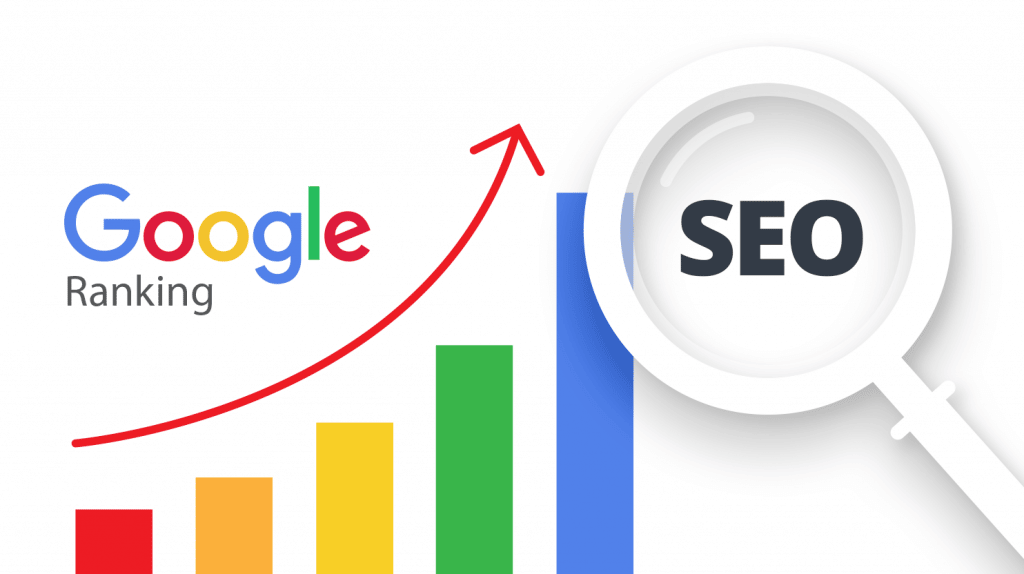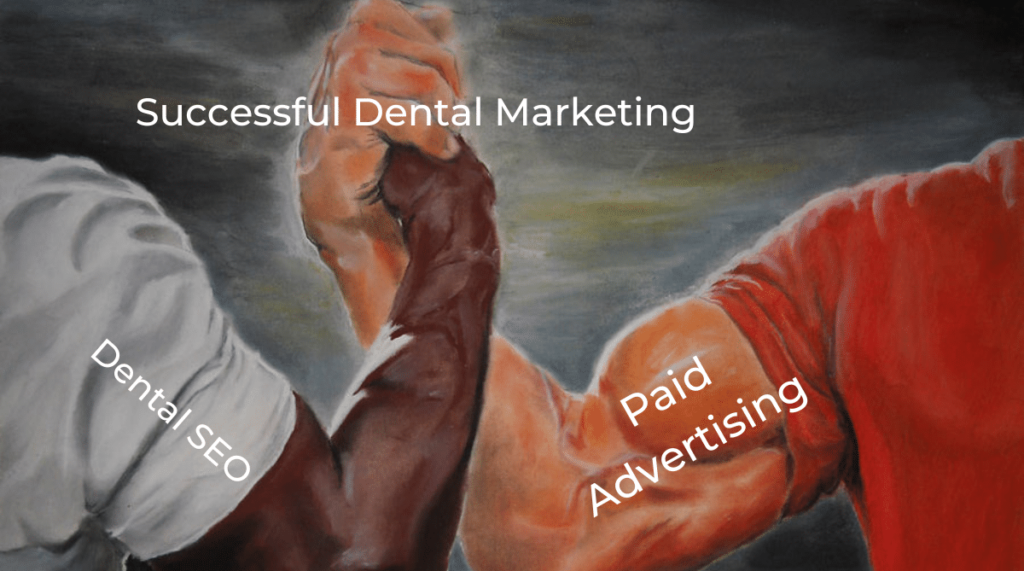Dental SEO vs. Paid Advertising on Google
Digital marketing has revolutionized how dental practices acquire new patients. With the advent of paid advertising on Google and dental search engine optimization (SEO), dentists now have an arsenal of tools to attract potential patients online. While both marketing strategies have their unique strengths, it’s essential to understand how they differ, which is best for […]

Digital marketing has revolutionized how dental practices acquire new patients. With the advent of paid advertising on Google and dental search engine optimization (SEO), dentists now have an arsenal of tools to attract potential patients online. While both marketing strategies have their unique strengths, it’s essential to understand how they differ, which is best for your needs, and how they can work together to maximize new patient acquisition!
What are Paid Ads on Google?
Paid advertising on Google, or Google Ads, is a popular method of promoting dental practices. This advertising model allows dentists to pay for their practice to appear at the top of Google’s search results for specific search terms or keywords. These ads usually appear as sponsored listings or as part of Google’s Local Service Ads. Here’s an example:

Benefits of Paid Ads on Google for Dentists
Paid advertising on Google has several benefits that make it an attractive marketing strategy for dental practices:
1.) Google Ads can provide immediate results. Once you create a Google Ads campaign, your practice can appear at the top of the search results within hours, instantly boosting visibility and traffic. This is a good strategy for start-ups, for example, who have just created a new website and need to build awareness in their local community immediately. It’s important to note that with Google Ads, you pay Google a fee each time someone clicks on your ad. This model is called “pay-per-click”.
2.) Google Ads allows for precise targeting. You can specify the search terms or keywords that trigger your ads to appear, ensuring that you only reach potential patients who are searching for the services you offer. You can also target specific geographic locations, ensuring you only appear to people within your service area.
3.) Google Ads provides detailed tracking and reporting. You can monitor how many people are clicking on your ads, which keywords are performing best, and which ads are generating the most conversions (phone calls or emails on the website, for example). This data allows you to optimize your campaign continually, ensuring you get the best possible return on your investment.
4.) Use Google Ads to increase new patient numbers for specific dental services. You can do this by creating targeted ads that appear only when potential patients search for specific services such as Invisalign, veneers, or dental implants. You can set separate budgets for the different services, customize what the ads say, and even the website page you will take the patients to once they click on the ad. This level of customization allows marketers to order to provide a cohesive experience when promoting a specific dental service.
While paid ads on Google do have many benefits, they can be costly and require ongoing investment to maintain their effectiveness for some dental practices. That’s where SEO comes in as a long-term strategy. Dental SEO involves optimizing your website and your overall digital presence to improve your practice’s visibility and ranking on Google’s search results page, which can drive organic traffic (where you don’t have to pay Google a fee for each click) and new patient acquisition over the long term. While dental SEO may take time to see results, it provides long-lasting benefits and can provide a sustainable return on investment for your dental practice. Let’s take a closer look!
What is Dental SEO?
Dental search engine optimization, or dental SEO, is the process of optimizing a dental practice’s website and overall online presence to improve its ranking on Google’s search results page for specific search terms or keywords like “Dentist near me” or “Cosmetic Dentist Dallas.” Dental SEO involves various tactics, such as optimizing website content, perfecting your Google Business profile, and improving website speed and user experience (To name a few).

Benefits of Dental SEO for Dentists
Just like paid ads on Google, Dental SEO also has many benefits that make it an essential component of any dental marketing strategy:
1.) SEO provides long-term results. While dental SEO may take longer to show results than paid advertising, the results are long-lasting. Once you achieve a high ranking on Google’s search results page, you’ll continue to receive organic traffic for as long as you maintain your position.
2.) Dental SEO is cost-effective. While it may require an initial investment to optimize your website, and Google My Business, and build high-quality backlinks, the ongoing costs are minimal compared to the ongoing costs of paid advertising. Once you achieve a high authority on Google and begin to rank on the first page, you can get clicks without having to pay every time; that’s one of the main reasons SEO is more cost-effective in the long-term.
3.) Dental SEO provides credibility and trust. People tend to trust websites that appear at the top of Google’s search results. By achieving a high ranking, you’re establishing yourself as a credible and trustworthy dental practice, which can help attract new patients. While paid ads can help with awarness, users often scroll past the ads section and click on the first organic result because they trust it more. They understand it was not paid for and that Google believes it is the best answer to their question.
How Paid Ads on Google and Dental SEO Work Together
While paid advertising on Google and dental SEO have their unique strengths, they can work together to produce the most value for a dental practice. Here’s how you can combine Dental SEO and Paid Advertising to ensure success for your dental practice:
Use paid advertising to target high-intent keywords: Use Google Ads to target high-intent keywords with low ranking or high competition. By targeting these keywords, you can ensure that your practice appears at the top of the search results for terms that are most likely to convert into new patients.
Use dental SEO to target low-intent keywords: While paid advertising is an excellent way to target high-intent keywords, dental SEO is ideal for targeting low-intent keywords. These are keywords that people use when they’re researching dental procedures or services but may not be ready to make an appointment yet, but want to know more. By targeting these keywords with SEO, you can establish your practice as a credible and trustworthy source of information, which can help convert these potential patients into new patients over time.
Use paid advertising to test new keywords and offers: Paid advertising is an excellent way to test new ones before committing to a long-term SEO strategy. By running ads for specific keywords and offers, you can measure their performance and determine whether they’re worth investing in for long-term SEO efforts.
Use dental SEO to improve website visibility and user experience: While paid advertising can provide an immediate boost in visibility, dental SEO is essential for improving your website’s overall visibility and user experience. Optimizing your website’s content, structure, and speed can improve your website’s ranking on Google’s search results page and provide a better user experience for potential patients.

Both paid advertising on Google and dental SEO have unique strengths, but they can work together to provide the most value for a dental practice. Both strategies require ongoing effort and optimization to produce the best results, but when done correctly, they can provide a significant return on investment for your dental practice!
Understanding the Right Strategy for Your Dental Practice’s Stage
Your dental practice’s stage (Start-up, expanding, ready-to-sell) plays a critical role in determining the right marketing strategy for your needs. Here’s a quick guide to help you understand which strategy or combination of Dental SEO and Paid-Media works best for each stage:
A Dental Start-Up
At this stage, your primary goal is to create awareness of your new practice and attract your first patients. A combination of both Google Ads and dental SEO can be effective:
Google Ads: When starting a new dental practice, it’s important to let potential patients know that you exist, and Google Ads can help you achieve that goal. You can drive relevant traffic to your website and create brand awareness by targeting specific keywords, demographics, and locations. Use Google Ads for immediate visibility and to generate quick leads. This can help jumpstart your practice by attracting new patients right away. Google Ads is an excellent way to generate quick leads and attract new patients immediately.
Example: If you are a start-up that wants to focus on dental implants, you can target the keyword “dental implants” locally in your Google Ads campaign. This way, when someone searches for dental implants in your area, your ad will appear at the top of the search results. This will help brand recognition and help potential patients associate your practice with this type of dental treatment. This can be repeated for any dental treatment important to you.
Dental SEO: By investing in dental SEO from the beginning, you can build a strong foundation for long-term growth. While you may not see immediate results, focusing on dental SEO from the beginning will pay dividends in the future as your practice becomes more established. Once you build authority and rank in the top results organically, you will no longer need to pay for the top spot on Google, which means you save money in the long run!
Example: As a dental start-up, make sure you optimize your website’s content by creating high-quality service pages that target specific keywords related to your services and what potential patients are searching for. Also, ensure your website has a great user experience by making it mobile-friendly, easy to navigate, and fast to load! You also need to make sure you have a Google My Business. You can learn more about the importance of having a Google Business Profile here.
An Existing Dental Practice That Wants to Increase New Patient Numbers
If your practice is already established but looking to attract more new patients, both Google Ads and dental SEO can play an essential role:
Google Ads: Google Ads is an effective way to target specific services or high-intent keywords to drive more traffic and increase new patient numbers quickly. You can use Google Ads to promote your new services, offer special promotions, or target specific demographics to fill gaps in your schedule.
Example: You can create a Google Ads campaign that targets the keyword “emergency dentist” in your area. This way, your ad will appear at the top of the search results when someone searches for an emergency dentist. This can also be done for promotions like Invisalign specials, teeth whitening promotions, and more!
Dental SEO: Dental SEO is still important for an established practice, as it can help you attract more potential patients who are still in the research phase. By focusing on low-intent keywords, user experience, and good content on your service pages, you can improve your website’s Google search rankings and attract more potential patients!
A Dental Practice That Is Getting Ready To Sell and Wants to Boost Production
If you’re preparing to sell your practice, your marketing strategy should primarily focus on increasing production and showcasing your practice’s success. Showing that you are a trusted brand in the area, with proven success and a solid patient base, is extremely important and will impact the perceived value of your dental practice.
Google Ads: Utilize Google Ads to promote high-value services and treatments. This can help boost overall production numbers and make your practice more attractive to potential buyers. By targeting keywords related to high-value treatments, such as “dental implants” or “cosmetic dentistry,” you can attract patients who are willing to pay more for your services.
Dental SEO: Invest in dental SEO to maintain your practice’s credibility and trustworthiness. High search rankings for important services signal that your practice is well-established and successful at dental marketing, which can make it more appealing to potential buyers. If a buyer knows that the practice is already ranking in the top 3 spots on Google for various dental treatments, they know your brand has visibility, and new patients will likely find the practice. If you do not rank well on Google, the new owners would need to rely heavily on Google Ads, which could impact the deal’s attractiveness.
Ready to Find the Perfect Marketing Strategy for Your Dental Practice? We Can Help!
At Pain-Free Dental Marketing, we have helped over 200 dental practices find the perfect balance between paid advertising and Dental SEO! We understand that each practice is unique, and that’s why we tailor every dental marketing strategy to fit your needs with a holistic approach via multiple dental marketing services. The next step in growing your dental practice starts here… So what are you waiting for? Contact us today to get the breakdown.
